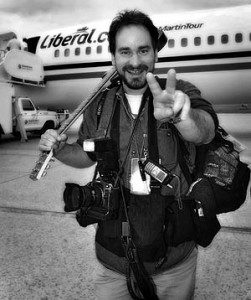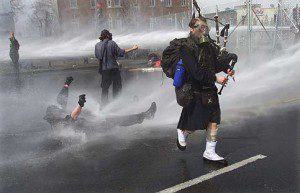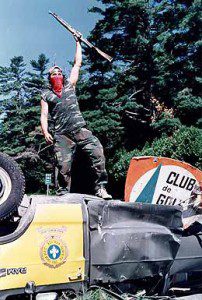The Canadian Angle
When photographer Tom Hanson died at 41, he left behind a body of work that reflects a unique vision of Canada—one captured by a man willing to indulge both his sensitive and aggressive sides
Tom Hanson is on the first green of the Royal Ottawa Golf Club in Gatineau, Québec. The Canadian Press photographer and his long-time colleague, Jonathan Hayward, are there to shoot the LPGA’s du Maurier Classic and someone has spray-painted “Go Canada Go” on the green a week after Canadian Lorie Kane won her first career title in Eureka, Missouri. Standing beside the tribute, Hanson and Hayward can see the red paint doesn’t look like much. If they want the shot, they’ll have to go up. “Jonny, you’re goin’ up that fuckin’ tree.”
Hanson puts Hayward—camera equipment and all—on his back and lifts him to the lowest branches. “Hey Tom, I can’t climb this fuckin’ tree.” Hayward’s gear weighs him down, but he manages to hoist himself up and can hear Hanson in the earpiece of the cheap walkie-talkies they’re using. “Hey Jon, how does it look?”
Not bad, but I could go higher.”
“Well, go higher!”
Hayward scales most of the tree just before the golfers hit the green. As they play, Hayward hears a branch snap. Hanson hears it too. “Don’t be so fuckin’ loud. You’re going to get kicked out of here.”
Though it was his direction that led to the LPGA tournament photo, Hanson let Hayward snap the picture that became a two-page spread in Sports Illustrated. Hanson, who died of a heart attack at 41 while playing hockey in March, sometimes came across as gruff—cursing at Hayward, riding up to the Governor General’s residence on his Harley and giving Parliament Hill staffers hell for denying photographers access to politicians—but the cowboy persona was only his first layer. “He seemed like a Maurice ‘Mom’ Boucher,” says CP’s Montreal news editor Alex Panetta, referring to the former president of the Hells Angels’ Montreal chapter, “but he really had the disposition of a Shakespeare.” It was these sides Hanson tapped into when taking photos, with his hard-nosed approach and his discerning eye coming together to capture the human side of Canadian history.
When Hanson started freelancing for CP’s Montreal bureau in 1989, he wasn’t an outspoken character. “If you want to get ahead, you keep your mouth shut and your ears open. And that’s what he did,” says Ryan Remiorz, Hanson’s CP colleague and friend. “He let his pictures do the talking.” He shot the picture that spoke the loudest while covering the Oka Crisis the same year he started at CP. The conflict between the Mohawks and the town’s people had been brewing for about a month and, after an unsuccessful attempt by the police to dismantle the Mohawk protest, police established their own blockade to restrict access to the town. Hanson and John Kenney, a photographer for Montreal’s The Gazette, found a back road in and made a dash for the top. Hanson snapped the iconic image of Mohawk warrior Richard Livingston Nicholas—rifle in hand, arm raised and standing atop an overturned Sûreté du Québec truck. (Coincidentally, Nicholas died the same day as Hanson, also at age 41.)
CP’s Ottawa bureau hired Hanson full-time in 1992. He went on to win several awards, including NPAC’s 2001 Picture of the Year for a photo he took at the Summit of the Americas. Fred Chartrand, Hanson’s mentor and long-time CP colleague, remembers him coming in from the protests reeking of tear gas, but excited about one particular shot: it showed a gas mask-wearing bagpiper with water-cannoned protesters behind him. Everyone else was just as excited, including the newspapers that picked it up.
But protest shots weren’t the only ones Hanson was after. He was always determined to bring home the Canadian angle of any event he covered. Hanson shot the 2000 Sydney Olympics with Remiorz and Kevin Frayer, and stood at the highest position possible in the crowd during the opening ceremonies. The three heard the athletes were going to unfurl a massive Canadian flag, so Hanson was perfectly placed when they did—except the flag was turned the wrong way for his shot. Hanson called the chef de mission and screamed at him, “The flag’s upside down! The flag’s upside down! Tell them to turn it around!” The flag slowly turned to face Hanson, giving him his Canadian angle.
Back at home, he spent most of his time at Parliament Hill. Hanson, who wasn’t above standing outside on a winter day to take a routine shot of a politician, was a fierce defender of the rights of photographers and reporters when it came to getting access on the Hill. But he’d sometimes leave aside his biker facade, playing his guitar on the election campaign plane and convincing reporters and political staff to sing along. Hanson’s guitar came out again when he played alongside photographers Moe Doiron, Peter Jones and Denis Cyr in a band called Velvet Jones and Sexual Chocolate (which they took from a Saturday Night Live skit when scrambling to find a name before playing at Ottawa’s Duke of Somerset pub). “Tom was a real guy’s guy,” says Doiron. “He liked to drink, he never wore suits. It was always black jeans and biker boots.”
Although one of the boys, Hanson called his wife, Catherine, every day—no matter where an assignment took him. Catherine is now on the selection committee for the CJF’s Tom Hanson Photojournalism Award, which gives a photojournalist in the early stages of his or her career a six-week internship at CP’s Toronto office. His friends think that’s the way Hanson would have wanted it. “He had a very warm heart. He always had time to help,” says Hayward. “If he saw that you were someone who wasn’t going to waste his time and that you had potential, he gave you the world.”
Jill Langlois was the Chief Copy Editor for the Spring 2010 issue of the Ryerson Review of Journalism.















































